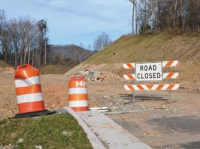Macon’s reval: unplugged and uncensored
The time of reckoning is finally here.
Macon County’s first countywide assessment of real estate values since the bust came out this week, and it’s full of surprises. For starters, your property values probably didn’t go down as much as you thought they would.
The Smoky Mountain News sat down with Richard Lightner, Macon’s tax administrator, to debunk some of the commonly held myths surrounding the reval.
Reval myth #1: Since my property value went down, my taxes will go down.
Not so fast. Overall, there’s a 15 percent decline in property values. But the county will likely hike the tax rate by 15 percent to make up for it.
So while your value may go down, the tax rate will go up, and that may offset that hoped for property tax decrease.
Whether your own taxes go up, down, or stay the same depends on where you fall on the spectrum.
Related Items
For those who saw the average decline of 15 percent, your property tax bill will be a wash.
For those who saw less of a decline, or even saw an increase, rejoice in the fact your property values fared better than most, and then brace for higher property taxes.
If your property value went down more than the average of 15 percent, embrace the consolation prize of your property taxes coming down.
“Now we are bringing everything back to a normal footing. The people who may have been overbilled because their values were inflated are going to see some relief now that they’ve dropped, and those who were getting a break before will now have to pick up a bigger share,” Lightner said.
Reval myth #2: The real estate market tanked, so my property value should be a lot lower than before.
True, the real estate market tanked, but it’s not as bad as you might think. Some areas of the county barely saw a decline at all, like houses convenient to downtown Franklin and downtown Highlands.
“People want to be downtown, within walking area of all that is going on,” Lightner said.
Values for high-end, second-home, resort-style property plummeted the most — after all, they had further to fall. Vacant subdivision lots, another hot item during the boom, also fell more steeply. But median-priced homes and starter homes held fairly steady, since they weren’t all that inflated in the first place.
Reval myth #3: The real estate market bottomed out a while ago, and property values have come back now.
Yes and no.
While the recession and real estate bust is in the rearview mirror nationally, a turnaround has been slower coming here — particularly in the second-home and vacation market.
“We are just now entering into a recovery,” Lightner said.
The real estate recovery in the mountains is lagging behind, but likewise, the recession was slower to hit here.
“It took a while to enter a full-blown recession in Western North Carolina. The results didn’t start showing up here until 2009 and 2010,” Lightner said.
Nationally, the real estate market hit bottom a few years ago and began going back up. But values were still going down in the mountains until quite recently.
“We are such a large second-home market and you look at where the investors and buyers are from, it’s Florida and Atlanta,” Lightner said. “That’s where the money was coming from. They have to recover there first and make their money there before we see it here.”
Reval myth #4: The reval is mostly a guessing game. County appraisers don’t even visit each property when appraising it.
Actually, they do. All 44,000 parcels.
The county’s team of appraisers divvies up the county into territories and systematically combs them until they’ve visited each piece of property. They don’t go inside homes, so they don’t know if you have granite counter tops or marble tile. But they probably walked around on your property — they have the right to trespass — to stack it up against other houses in the neighborhood, and ultimately score it against similar property that’s sold recently.
Appraisers use recent sales in the neighborhood to set a baseline, and from there, adjust the value up or down for each property based on its characteristics.
Does it have more bedrooms than the house that sold down the street? How old does the roof look? Is there an eyesore next door or highway noise? What type of road does it have?
“Are you on a paved road, state road, private road, private paved road, private gravel road, private dirt road?” Lightner asked.
The view is also of paramount importance.
“Is it a panoramic view, good view, excellent view, lake view, mountain view, no view?” Lightner said.
The combination of variables are endless but are ultimately tailored to the DNA of the individual property when setting its value.
“I have to worry about equality,” Lightner said. “That Mr. Jones in his three-bedroom house is treated the same as Mr. Smith in his three-bedroom house.”
Reval myth #5: A flood of foreclosures and fire sales in defunct second-home developments skewed the reval.
They could have, if they were counted, but they weren’t.
Real estate was unloaded at rock-bottom prices after the bust, not only at foreclosures on the courthouse steps but in behind-the-scenes short sales, fire sale auctions, and get-‘em-while-supplies-last hype sales.
Considered distressed sales, the sale price in these scenarios is often lower than it would be in a normal arms-length transaction.
If these auctions, foreclosures and fire sales were factored into the mix, they would falsely bring down the average selling price.
So appraisers kicked those sales out, and don’t consider them when sizing up the true going rate of real estate.
Likewise, property sales among family members, post inheritance sales by groups of heirs, and adjustments to property lines between neighbors. These are also tossed out of the equation as well since they don’t reflect the real world values.









